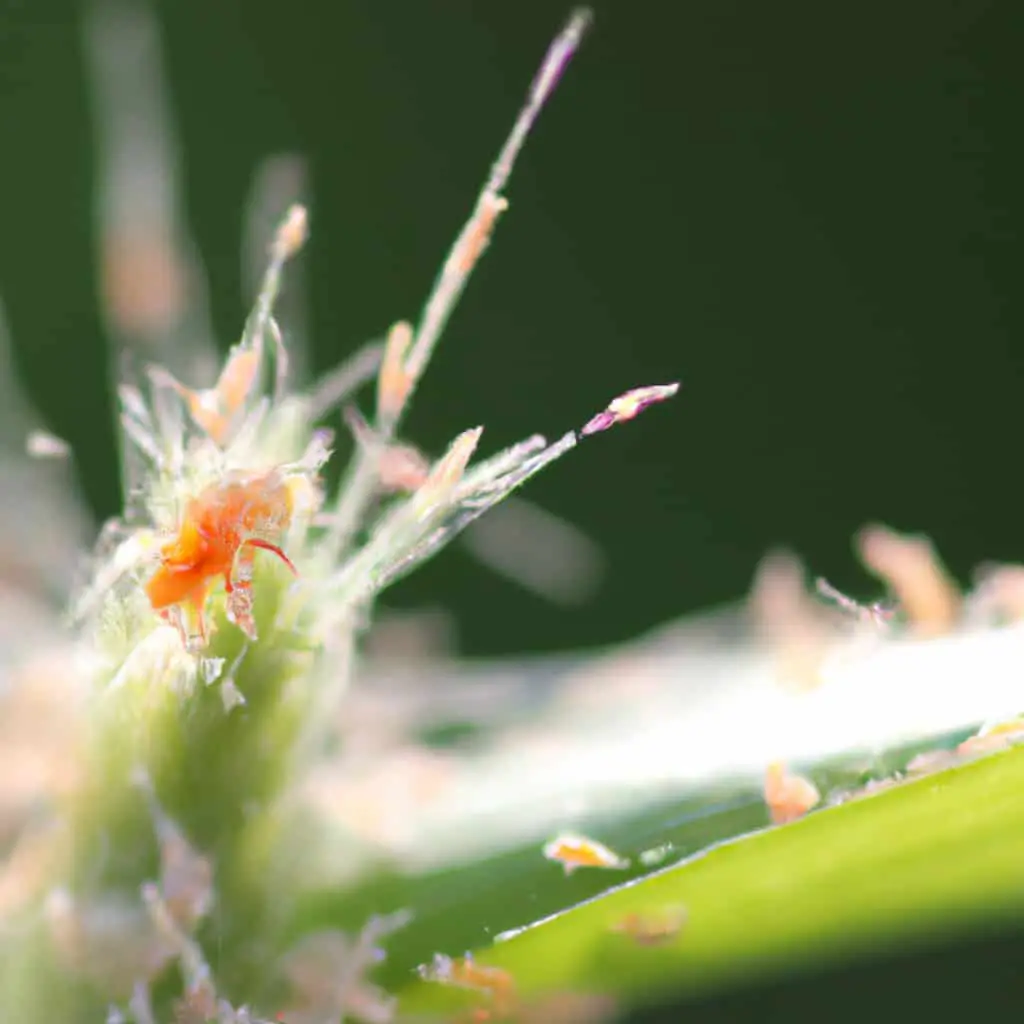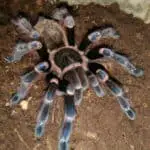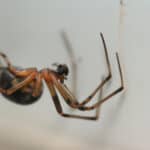As a gardener, you may have heard of spider mites, but do you know how far they can travel? These tiny pests are notorious for their ability to infest plants quickly and easily, but just how far can they spread? In this article, we will explore the distance spider mites can travel and how it impacts plant health.
Spider mites are incredibly small, which means they can travel long distances without being noticed. These pests can move up to 1/4 inch per day, which may not seem like much, but it can quickly add up. They can hitch a ride on clothing, furniture, or even other plants, making it easy for them to spread from one plant to another. This means that a single infestation can quickly become widespread, leading to severe damage to your plants.
Key Takeaways
- Spider mites can travel up to 1/4 inch per day, making it easy for them to spread from plant to plant
- These tiny pests can hitch a ride on clothing, furniture, or even other plants
- A single infestation can quickly become widespread, leading to severe damage to your plants

Understanding Spider Mites
As arachnids, spider mites belong to the Acari subclass, which means they have eight legs and are related to ticks and spiders. The Tetranychidae family includes around 1,200 genera of spider mites, and they are known to feed on hundreds of plant species. Some of the most common types of spider mites are the red spider mite, white spider mite, and two-spotted spider mite (Tetranychus urticae).
Spider mites are tiny, measuring about 0.5 mm in length, and can be difficult to spot with the naked eye. They can be red, green, yellow, or brown, depending on the species and age. Spider mites reproduce quickly, and a single female can lay hundreds of eggs in her lifetime. The eggs hatch in two to four days, and the mites reach maturity in about a week.
Spider mites are known to cause significant damage to plants by puncturing the plant cells to feed on the sap. They can also spread diseases and viruses that can kill the plant. Spider mites are most active in hot and dry conditions, and their populations can explode in a matter of days if left unchecked.
To prevent spider mites infestations, it is essential to maintain a healthy and clean garden environment. Regularly inspecting plants for signs of infestation, keeping the humidity levels low, and avoiding over-fertilization can help prevent spider mites from taking hold.
In conclusion, spider mites are tiny arthropods that can cause significant damage to plants. They are highly mobile and can spread to other plants up to 100 feet away. Understanding their behavior and life cycle is essential to prevent infestations and protect your garden.
The Life Cycle of Spider Mites
As I researched spider mites, I learned that their life cycle is quite fascinating. These tiny parasites start their lives as eggs, which are translucent and hard to see with the naked eye. As they mature, the eggs become whitish opaque and more visible.
Once the eggs hatch, the juvenile spider mites emerge. These juveniles have eight legs and are similar in appearance to adult spider mites. They begin to feed on the plant’s vascular system, which is the system that moves nutrients from the roots up to the leaves.
Spider mites can reproduce quickly, with one female laying up to 20 eggs per day. Under optimal conditions, the two-spotted spider mite can hatch in as little as three days and become sexually mature in as little as five days.
As spider mites continue to feed and reproduce, they can quickly become a problem for plants. Hot, dry conditions are often associated with population build-up of spider mites, and they can spread as far as 100 feet from their point of origin.
To manage spider mites, it’s important to understand their life cycle. Regularly spraying plants with water can wash away spider mites, and predatory mites can be released into the garden to eat spider mites.
How Spider Mites Infest Plants
As we learned earlier, spider mites are tiny parasites that feed on plant cells, sap, and chlorophyll. They can infest a wide range of plants, including houseplants, ornamental plants, trees, tomatoes, cucumbers, roses, elms, and more. But how do they infest these plants?
Spider mites typically infest the undersides of leaves, where they are protected from predators and environmental factors. They use their sharp mouthparts to pierce the plant cells and suck out the sap, which can cause the leaves to turn yellow, dry up, and fall off. As they feed on the plant, they also inject toxins that can further damage the plant and make it more susceptible to other pests and diseases.
Spider mites can infest plants in a variety of ways. They can travel from plant to plant by hitchhiking on clothing, furniture, or other objects. They can also spread through wind-borne dispersion, which can allow them to travel long distances and infest new areas. Once they infest a plant, they can quickly multiply and spread to other parts of the plant and nearby plants.
To prevent spider mite infestations, it is important to regularly inspect your plants for signs of infestation, such as yellowing leaves, webbing, or tiny speckles on the leaves. You can also use preventative measures, such as keeping your plants well-watered and fertilized, and avoiding dusty conditions that can attract spider mites. If you do notice an infestation, you can use natural or chemical treatments to control the population and prevent further damage to your plants.
In conclusion, understanding how spider mites infest plants is crucial to preventing and controlling infestations. By taking proactive measures and monitoring your plants regularly, you can keep your plants healthy and free from these pesky pests.
Signs of Spider Mite Infestation
As spider mites are tiny, it can be challenging to detect them until they have caused significant damage to plants. However, there are a few signs of spider mite infestation that you can look out for to detect them early.
One of the most common signs of spider mite infestation is the presence of webbing on the undersides of leaves. These webs are often accompanied by speckled or stippled discoloration on the leaves, which can range from yellow to brown. Additionally, spider mites can cause the leaves to become dusty and appear to have dark spots.
Another sign of spider mite infestation is the appearance of tiny black dots, which are actually mite droppings. These droppings can be found on the leaves, the soil, and even on nearby surfaces.
It is essential to monitor your plants regularly for these signs of infestation, especially if you have had spider mites in the past. Early detection and treatment can prevent severe damage to your plants and reduce the risk of spider mites spreading to other plants.
If you suspect that your plants have spider mites, you can confirm the infestation by shaking the leaves over a white piece of paper. If you see tiny specks moving on the paper, then you have spider mites.
In conclusion, it is crucial to keep an eye out for signs of spider mite infestation to protect your plants from severe damage. Regular monitoring and early detection can help prevent the spread of spider mites and keep your plants healthy.
How Far Can Spider Mites Travel
As a gardener, it’s important to know how far spider mites can travel to prevent their spread. According to research, spider mites can travel up to several hundred meters in search of food sources, with the exact range depending on environmental conditions.
Spider mites are tiny arachnids that can hitchhike on clothing or furniture, making it easy for them to spread from place to place. They can also use silk webs and threads to move from plant to plant, creating a colony that can quickly infest an entire area.
While spider mites can crawl on their own, they can also be carried by the wind. This means that even if you don’t see any spider mites in your garden, they could still be present if the wind has carried them from a nearby infestation.
To prevent the spread of spider mites, it’s important to regularly inspect your plants for any signs of infestation. If you do find spider mites, it’s best to call in the exterminators to prevent the spread of the colony.
In summary, spider mites can travel up to several hundred meters and can spread through hitchhiking, silk webs, and the wind. Regular inspections and prompt action can help prevent the spread of these tiny pests.
Spider Mites and Humans
As tiny arachnids, spider mites are not known to pose any significant threat to humans. However, they can still cause some problems if they come into contact with people.
One way spider mites can affect humans is by hitching a ride on clothing. As mentioned in the search results, spider mites can travel about 1/4 inch per day. If they happen to be on clothing, they can easily be transported to a new location. This means that if you have been in an area with spider mites, it’s possible that you could bring them home with you without even realizing it.
Another way spider mites can affect humans is by occasionally biting them. Although it’s unlikely that you would feel the bite due to their microscopic size, you may notice small, red pimply marks on your skin that look like a rash. This can cause itching and swelling, but it’s generally not a serious issue.
To prevent spider mites from hitching a ride on your clothing, it’s a good idea to wear protective clothing when working in areas where they are present. This can include gloves, long-sleeved shirts, and pants. It’s also a good idea to wash your clothing after being in an area with spider mites to ensure that any hitchhikers are removed.
Overall, while spider mites can be a nuisance to humans, they are generally not a serious threat. By taking some simple precautions, you can minimize your risk of coming into contact with them.
Indoor vs Outdoor Spider Mites
As their name suggests, spider mites are most commonly found outdoors, where they can easily infest a wide range of plants. However, they can also make their way indoors, where they can wreak havoc on houseplants and other indoor greenery.
Indoor spider mites are often the result of infested plants being brought inside. Once inside, these mites can quickly spread to other plants, and can be difficult to get rid of.
One of the main differences between indoor and outdoor spider mites is that indoor mites tend to reproduce more quickly. This is because indoor environments are often warmer and more humid than outdoor environments, which provides ideal conditions for mite reproduction.
Another difference between indoor and outdoor spider mites is the types of plants they infest. While outdoor spider mites can infest a wide range of plants, indoor spider mites tend to be more selective, and are often found on houseplants and other indoor greenery.
If you suspect that you have a spider mite infestation, it’s important to take action as soon as possible. This may involve removing infested plants from your home, or using insecticidal soap or other treatments to get rid of the mites.
Overall, while spider mites can be a problem both indoors and outdoors, taking steps to prevent infestations and promptly addressing any infestations that do occur can help keep your plants healthy and thriving.
Preventing and Treating Spider Mite Infestations
As with any pest, prevention is key to avoiding spider mite infestations. Regularly inspecting your plants for signs of spider mites, such as webbing and yellowing leaves, can help you catch an infestation early. Quarantining new plants before introducing them to your collection can also help prevent the spread of spider mites.
If you do find spider mites on your plants, there are a few treatment options available. One simple method is to use a mixture of soap and water to wash the leaves and stems of the affected plants. Insecticidal soap, which is specifically formulated for use on plants, can also be effective.
If the infestation is more severe, systemic insecticides may be necessary. These insecticides are absorbed by the plant and kill spider mites when they feed on the plant. However, it’s important to follow the instructions carefully and only use systemic insecticides as a last resort.
Biological control is another option for treating spider mite infestations. Predatory mites, which feed on spider mites, can be released into your garden to help control the population. Beneficial insects, such as ladybugs and lacewings, can also be effective.
Preventing spider mite infestations is always preferable to treating them. Regularly inspecting your plants, quarantining new plants, and providing proper care can all help prevent spider mite infestations from occurring in the first place.
Spider Mites and Other Animals
As a pet owner, it’s important to know how far spider mites can travel. These tiny pests can easily hitch a ride on your furry friend and travel great distances. According to my research, spider mites can travel up to 100 feet from their point of origin. That’s a long way for such a small creature!
But spider mites aren’t the only pests that can travel on pets. Fleas, ticks, and even bed bugs can also hitch a ride on your pet and travel into your home. It’s important to regularly check your pets for these pests and take preventative measures to keep them off.
In addition to pets, other animals can also carry spider mites. Birds and rodents, for example, can easily transport spider mites to new locations. It’s important to keep your home and yard clean and free of debris to discourage these animals from nesting.
Overall, it’s important to be aware of the potential for spider mites and other pests to travel with pets and other animals. Regularly checking your pets and keeping your environment clean can help prevent infestations.
Impact of Environmental Conditions on Spider Mites
As we know, spider mites are tiny arachnids that can cause significant damage to plants. However, their mobility is also affected by environmental conditions. Let’s take a closer look at how temperature, humidity, and other factors can impact the range of spider mites.
Temperature: Spider mites are cold-blooded, meaning their body temperature is regulated by the environment. They are active in warm temperatures and tend to become dormant in cold temperatures. According to research, spider mites can travel up to several hundred meters in search of food in optimal temperatures. However, if the temperature drops below their preferred range, their mobility decreases significantly.
Humidity: Spider mites prefer dry conditions, and low humidity can increase their mobility. In humid conditions, spider mites tend to stay put and reproduce more rapidly. However, if the humidity drops to extremely low levels, their mobility can decrease, and they may become dormant.
Winter: During the winter months, spider mites tend to become dormant and do not travel as much. They may also seek shelter in protected areas, such as under leaves or in cracks in the bark of trees. However, if winter temperatures are mild, spider mites may remain active and continue to travel in search of food.
Environmental conditions: Spider mites are affected by various environmental factors, such as wind speed, rainfall, and soil moisture. High winds can limit their mobility, while rainfall and soil moisture can affect their food sources and reproduction rates.
In conclusion, spider mites are highly mobile pests that can travel several hundred meters in search of food. However, their mobility is impacted by various environmental conditions, such as temperature, humidity, and wind speed. By understanding these factors, we can better manage and control spider mite populations.
Spider Mites in Gardens and Agriculture
As a gardener or farmer, you may be wondering how far spider mites can travel. These tiny insects can cause significant damage to plants, particularly in dry and hot conditions. Here’s what you need to know about spider mites in gardens and agriculture.
Spider mites are common pests that affect a wide range of plants, including vegetables and fruits. They feed on plant sap, causing yellowing and discoloration of leaves, and in severe cases, plant death. Spider mites are known for their ability to reproduce quickly, with some species capable of producing more than 100 eggs per female in just a few days.
In gardens, spider mites can be controlled through cultural and biological methods. Adequate watering of plants during dry conditions can limit the importance of drought stress on spider mite outbreaks. Periodic hosing of plants with a forceful jet of water can physically remove and kill many mites, as well as remove the dust that collects on foliage and interferes with mite predators. You can also release predatory mites into your garden to eat spider mites.
In agriculture, spider mites can be a significant problem, particularly in hot and dry conditions. According to the Center for Agriculture, spider mites can go from egg to reproductive adult within five days when temperatures are in the 90º-100º F range. Farmers can control spider mites through the use of insecticides, but this can also harm beneficial insects and lead to the development of resistant spider mite populations.
To prevent spider mite infestations in agriculture, farmers can use integrated pest management techniques. This involves monitoring crops for spider mites and using a combination of cultural, biological, and chemical control methods to manage populations. Some cultural methods include crop rotation, use of resistant cultivars, and maintaining healthy soil.
In conclusion, spider mites can be a significant problem in gardens and agriculture, particularly in hot and dry conditions. However, with proper management techniques, it is possible to control populations and prevent infestations.
Spider Mites and Other Arachnids
As a gardener, I know how frustrating it can be to deal with pests like spider mites. These tiny arachnids can quickly infest and damage a wide range of plants. But just how far can they travel?
According to my research, spider mites can travel surprisingly far – up to 1/4 inch per day. This means that a single infestation can quickly become widespread, especially if the critters hitch a ride on clothing or furniture.
Spider mites belong to the Tetranychidae family, which has around 1,200 species, and they are part of the Acari subclass of mites. While they may be small, they are not the only arachnids that can cause problems for gardeners.
Spiders, for example, can also be a nuisance in the garden. While most spiders are harmless and even beneficial, there are a few species that can pose a threat to humans. The black widow spider, for example, is venomous and can cause serious health problems if bitten.
It’s important to take precautions when dealing with arachnids in the garden. Wearing gloves and protective clothing can help prevent bites and infestations. Regularly inspecting plants for signs of pests can also help catch infestations early, before they have a chance to spread.
In conclusion, while spider mites may be small, they can travel surprisingly far and quickly infest a garden. It’s important to take precautions and regularly inspect plants for signs of pests to keep your garden healthy and thriving.
Conclusion
After conducting research and analyzing the information available, it is clear that spider mites are capable of traveling significant distances in search of food sources. While the exact range of their mobility can vary depending on environmental conditions, spider mites can spread up to 100 feet from their point of origin.
Spider mites are small and can travel up to 1/4 inch per day, which means that they can quickly infest plants in a relatively short amount of time. They are not equipped with wings, but they can produce silk threads that allow them to float in the wind and travel to new locations.
It is important to note that infestations of spider mites can cause significant damage to plants and crops. Therefore, it is crucial to monitor and control spider mite populations to prevent infestations from spreading.
Some methods for controlling spider mites include using insecticidal soaps or oils, introducing natural predators such as ladybugs or lacewings, and maintaining healthy plant growth through proper watering and fertilization.
Overall, understanding the mobility of spider mites is essential for preventing infestations and protecting plants from damage. By implementing effective control measures and monitoring spider mite populations, gardeners and farmers can help to maintain healthy plant growth and prevent crop losses.
Frequently Asked Questions
How far can spider mites spread?
Spider mites are tiny pests that can travel surprisingly far. According to Oh Gardening!, spider mites can spread up to 100 feet from their point of origin, and they can travel about 1/4 inch per day. This means that a single infestation can quickly become widespread if left untreated.
Can spider mites travel between plants?
Yes, spider mites can easily travel between plants. They can hitch a ride on clothing, pets, or even wind currents. Once they reach a new plant, they can quickly infest it and start feeding on its sap. This is why it’s crucial to isolate and treat any infested plants as soon as possible.
Do spider mites live in houseplant soil?
Spider mites can live in soil, but they don’t typically burrow into it like some other pests. Instead, they tend to stay on the plant itself, feeding on its sap. However, they can still lay eggs in the soil, which can hatch and lead to a new infestation. To prevent this, it’s important to regularly inspect your plants and remove any dead leaves or debris from the soil.
How do you get spider mites on indoor plants?
Spider mites can enter your home through open windows or doors, or they can hitch a ride on clothing or pets. Once they’re inside, they can quickly infest your indoor plants. To prevent this, it’s important to regularly inspect your plants for signs of infestation and isolate any that are affected. You can also use natural predators like ladybugs or predatory mites to control the population.
Can spider mites live outside?
Yes, spider mites can live outside, and they can infest a wide range of plants. They tend to thrive in warm, dry conditions, so they’re most common in the summer months. To prevent infestations, it’s important to regularly inspect your outdoor plants and remove any dead leaves or debris.
How long can spider mites live in soil?
Spider mites can lay eggs in soil, which can hatch and lead to a new infestation. The eggs typically hatch within a few days, and the newly hatched mites can start feeding on the plant immediately. However, the lifespan of a spider mite varies depending on the species and environmental conditions. Some can live for several weeks, while others may only survive for a few days.








